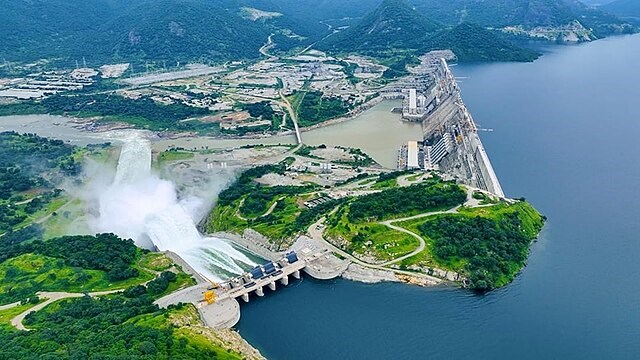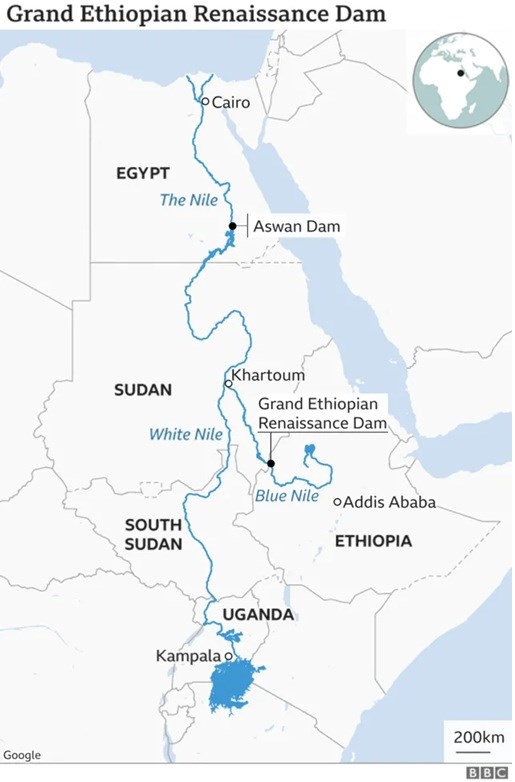
Sunday September 7, 2025

The Grand Ethiopian Renaissance Dam on the Blue Nile, near the Ethiopia-Sudan border, with water released from its spillways. The $5 billion hydropower project, Africa’s largest, has reshaped regional politics and triggered a decade-long dispute with Egypt and Sudan over water security. CREDIT/ Ethiopian News Agency
ADDIS ABABA, Ethiopia (HOL) — Ethiopia is preparing to fully inaugurate the Grand Ethiopian Renaissance Dam later this year, finalizing a project that has transformed the balance of power along the Nile and deepened a decade-long standoff with Egypt over water security.
The $5 billion hydropower project, begun in 2011 on the Blue Nile near the Sudanese border, is designed to generate more than 5,000 megawatts of electricity, enough to double Ethiopia’s power supply and export surplus energy to Kenya, Djibouti and, eventually, across the Red Sea. Ethiopia began partial operations in 2022 after impounding water in a reservoir nearly the size of London. Four successive fillings since 2020 have expanded storage to about 74 billion cubic meters, almost the annual flow of the Nile at Aswan and nearly double the capacity of China’s Three Gorges Dam.
For Addis Ababa, the dam has become a symbol of sovereignty and national pride. Ethiopians at home and abroad helped finance its construction through government bonds and donation drives. “Ethiopians may disagree on how to eat injera [their staple food], but they agree on the dam,” Moses Chrispus Okello, an analyst with the South Africa-based Institute for Security Studies think-tank, told the BBC.
But for Egypt, where more than 107 million people depend on the Nile for nearly all their freshwater, GERD represents an existential threat. Officials warn that without a legally binding deal on filling and drought-year operations, the giant reservoir could cut deeply into Egypt’s annual share of 55.5 billion cubic meters guaranteed under a 1959 treaty. “The Nile built Egyptian civilization. The Nile is our life,” said Abbas Sharaky, a geologist at Cairo University.
Sudan’s position has shifted sharply. Initially supportive of GERD for its potential to regulate flooding and provide cheap electricity, Khartoum grew alarmed after the first fillings in 2020 and 2021 caused uncoordinated surges and drops in the Blue Nile, forcing its Roseires Dam offline. Since then, Sudan has aligned more closely with Egypt, demanding real-time data sharing and guarantees on dam safety. The two countries have conducted joint military exercises, including “Nile Eagles” and “Guardians of the Nile,” signalling that water security is now part of their shared defence posture.
Years of negotiations have failed to resolve the dispute. A 2015 Declaration of Principles committed the three countries to cooperation and “no significant harm,” but Ethiopia pressed ahead with filling before completing impact studies. U.S.-brokered talks in 2019 and 2020 collapsed when Addis Ababa rejected a draft agreement it said infringed on sovereignty. President Donald Trump drew criticism during his last administration after warning that Egypt might “blow up” the dam, remarks Ethiopia condemned as incitement. The African Union has since chaired multiple negotiation rounds, while the U.N. Security Council in 2021 urged the parties to reach a “mutually beneficial, binding agreement,” but left resolution to the AU.
Egypt has sought alternatives to shore up water security, expanding desalination plants, drilling thousands of wells, and halving rice cultivation to cut water use. Yet Cairo maintains that only a binding treaty can safeguard its lifeline.
Ethiopia insists GERD will not harm downstream states and says Egypt must abandon colonial-era treaties that guaranteed it nearly 80 percent of the Nile’s flow. Egypt maintains that only a written, enforceable treaty can protect its water lifeline.
The dispute has drawn in wider regional and global actors. The Arab League has backed Egypt and Sudan, while upstream African countries, including Kenya, Uganda and Tanzania, support Ethiopia’s call for equitable water use. The United States and European Union have endorsed African Union mediation, while China, a major investor in both Ethiopia and Egypt, has quietly urged compromise. The United Arab Emirates has offered to mediate with economic incentives, underscoring Gulf interest in stability along the Nile.
Ethiopia’s ambitions also extend beyond the river. Prime Minister Abiy Ahmed has described the loss of Red Sea access after Eritrea’s independence in 1991 as a mistake “that must be corrected,” remarks Eritrea condemned as threatening. Ethiopia’s regional neighbours warn that Abiy’s rhetoric, coupled with GERD’s symbolism, reflects Addis Ababa’s bid to assert itself as a regional power.
Despite fiery rhetoric, open conflict remains unlikely. Analysts note that any strike on GERD would flood Sudan and risk regional war. Instead, the future of the Nile may hinge on whether Egypt, Ethiopia and Sudan can transform the dam from a source of rivalry into a platform for cooperation on shared water and energy.
- With files from the BBC Somali Service







